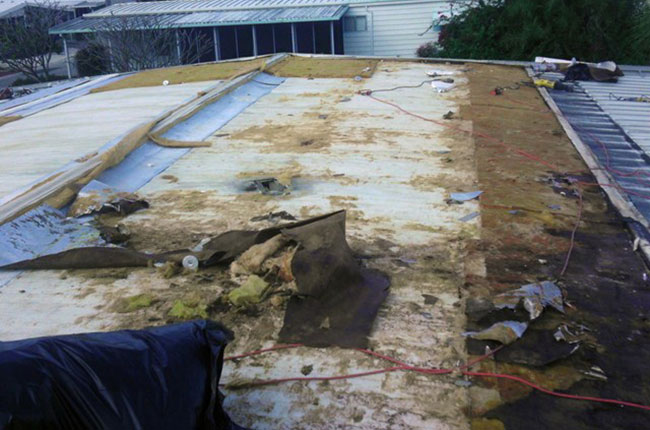
Table of Contents
Assessment of Roof Damage
The first step in repairing your mobile home roof is to assess the extent of the damage. Look for signs of leaks, such as water stains on the ceiling or walls, sagging areas, or missing shingles. Take note of any areas that need immediate attention, as well as any underlying structural issues that may need to be addressed.
Gathering Necessary Materials
Before you begin the repair process, gather all the necessary materials and tools. This may include replacement shingles, sealant, roofing nails, a hammer, a ladder, and safety gear such as gloves and goggles. You can find these supplies at your local hardware store or home improvement center.
Safety Precautions
Safety should always be a top priority when working on a mobile home roof. Wear sturdy shoes with good traction to prevent slips and falls, and use a harness or safety line if working at heights. Avoid working on the roof during inclement weather, and be mindful of electrical hazards if there are power lines nearby.
Repairing Leaks and Water Damage
One of the most common issues with mobile home roofs is leaks. To repair a leak, start by locating the source of the problem. Check for damaged or missing shingles, cracked sealant, or gaps around vents and chimneys. Patch any leaks with roofing cement or silicone sealant, and replace any damaged shingles as needed.
Replacing Missing or Damaged Shingles
If your mobile home roof has missing or damaged shingles, it’s important to replace them promptly to prevent further damage. Start by carefully removing the old shingles using a pry bar or hammer. Then, install new shingles according to the manufacturer’s instructions, making sure to overlap them properly for maximum protection against leaks.
Fixing Sagging or Uneven Areas
Sagging or uneven areas on a mobile home roof can indicate underlying structural issues that need to be addressed. To fix these problems, reinforce the roof structure with additional supports or braces. Use a level to ensure that the roof is properly aligned, and make any necessary adjustments to correct any sagging or uneven areas.
Sealing Joints and Seams
To prevent leaks and water damage, it’s essential to seal the joints and seams of your mobile home roof properly. Use a high-quality sealant, such as silicone or asphalt-based sealant, to fill any gaps or cracks around vents, chimneys, and other openings. Apply the sealant generously and smooth it out with a putty knife for a watertight seal.
Addressing Ventilation Issues
Proper ventilation is essential for maintaining a healthy roof and preventing issues such as mold and mildew growth. Make sure that your mobile home roof is adequately ventilated by installing vents or fans as needed. Clean out any debris or obstructions from existing vents to ensure proper airflow.
Inspecting and Maintaining the Repaired Roof
Once you’ve completed the necessary repairs, it’s important to inspect your mobile home roof regularly to ensure that it remains in good condition. Keep an eye out for signs of damage or wear, such as cracked sealant, loose shingles, or water stains on the ceiling. Address any issues promptly to prevent further damage and prolong the lifespan of your roof.
Cost Considerations
The cost of https://www.supermanfanart.com/ can vary depending on the extent of the damage and the materials used. DIY repairs can be more cost-effective than hiring a professional, but it’s essential to factor in the cost of materials and any specialized tools you may need. Shop around for the best prices on roofing supplies, and consider budget-friendly options to keep costs down.
DIY vs. Professional Repairs
Deciding whether to tackle mobile home roof repairs yourself or hire a professional is a personal choice. DIY repairs can save money but require time, effort, and a certain level of skill. If you’re not comfortable working on your roof or if the damage is extensive, it may be best to hire a professional contractor to ensure the job is done correctly.
Common Mistakes to Avoid
When repairing your mobile home roof, there are several common mistakes to avoid. These include using the wrong materials or techniques, neglecting proper safety precautions, and overlooking underlying structural issues. Take your time and follow the steps outlined in this guide to ensure a successful repair job.
Environmental Impact
Consider the environmental impact of the materials you use for mobile home roof repair. Opt for eco-friendly options whenever possible, such as recycled or sustainable roofing materials. Minimize waste by properly disposing of old shingles and other debris, and avoid using harsh chemicals that can harm the environment.
Conclusion
Repairing your mobile home roof is a manageable task with the right knowledge and tools. By following the steps outlined in this guide, you can address common issues such as leaks, damaged shingles, and sagging areas, and ensure that your roof remains in good condition for years to come. Don’t wait until it’s too late—take action to repair your mobile home roof today.


:fill(white):max_bytes(150000):strip_icc()/Light_Stream_Loans-e56c203492c44dba97aa3f6842791277.jpg)
